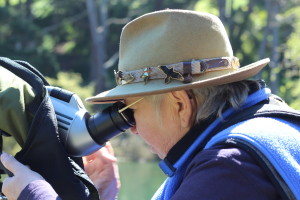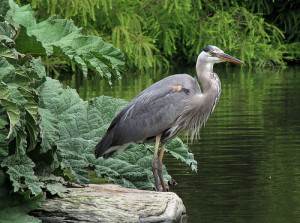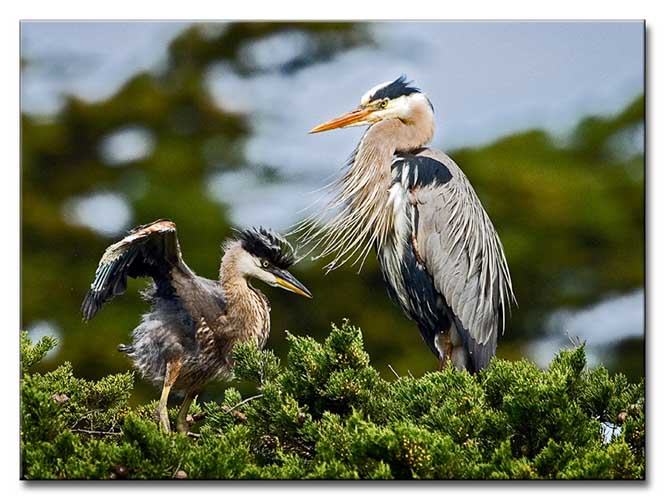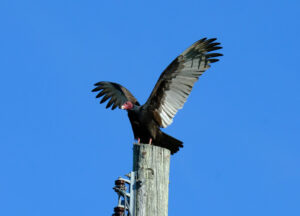It’s a warm spring morning and Nancy DeStefanis is seated outside the Stow Lake Boathouse, binoculars in hand, watching for any movement from the highest reaches of Heron Island. Flopped on her head is a beige sun hat, the same one she wore 20 years ago, dotted with a series of wildlife lapel pins.
Of course, the great blue heron is front and center.
Two decades have passed since DeStefanis discovered the first pair of nesting blue herons on what is now known as ‘Heron Island.’ Or, you might say the herons found her as this lawyer- turned- conservationist went on to establish the non- profit, San Francisco Nature Education and one of its most popular programs, ‘Heron Watch.’
Prior to her discovery, there was no record of great herons having ever nested in San Francisco; she says they most likely relocated because of a disturbance at their original colony. Heron Island proved an ideal spot: it’s largely free of predators, and given its relative isolation and ideal position by the water, it has become somewhat of a sanctuary for these birds during the six months they call it home.
The great blue heron is the largest and most common heron in North America. Standing at up to 4-feet tall and with a wingspan of over five feet, these long-limbed birds are easily recognized by their blue- grey color and slow, deliberate wing beats with which they navigate the sky. While the great blue can be found year round in the Bay Area, they arrive at Heron Island in January to prepare for the breeding season and will leave by the end of June after their chicks have fledged.
Towards the center of the island, in the highest reaches of a Monterey cypress, are four great heron nests known to be part of this year’s breeding colony. It is common practice for great herons to nest at the top of a tree.
“The thing about a great blue is that they love a great view,” DeStefanis says.
Their huge nests are a no-nonsense construction of sticks and branches which are not only reused season to season, but grow larger each year as the male offers the female several sticks during their courtship.

“Except for laying the eggs, the male and female of this species do everything together. In other words, the male doesn’t go off and leave,” says DeStefanis. “That’s why I say I like them so much — because they’re not sexist birds.”
Walking towards the concrete bridge at Stow Lake, we come across a pocket gopher emerging from its mound, hurriedly puffing its cheeks with the surrounding grass. The great heron’s dagger-like bill is highly adept to fishing for marine life, which is plentiful at Stow Lake, but they also feast upon insects and small mammals such as gophers and voles.
“When you see them carefully walking on the grass, you know they’re not just going for a nature walk. They’re going for the stab and grab,” says DeStefanis. “The great blue heron is very patient. They will just stand there and watch and watch until they get that guy, and BAM!”
On this particular morning, most of the herons are out gathering food and the action on Heron Island is slow; the remaining few sit perched in their nests watching over their young. Silhouetted against the clear sky, the wispy plumes on their breasts and heads, grown during the breeding season, are particularly prominent and give these birds a somewhat eminent presence at Stow Lake.
With a quick landing, a great heron returns to its nest and, for a moment, pauses to regurgitate food for its young. The quiet, yet guttural sound of the chicks’ call for food is audible above the Stow Lake cacophony and quickly sends the heron fishing once more. Compelled by the promise of lunch, two chicks pop their heads above the top of the nest and point their bills upwards, eager to fill their bellies.
Since the first nesting season, two decades ago, DeStefanis estimates that more than 150 chicks have been raised on Heron Island, and anywhere from one to 10 chicks will fledge each season. This season’s chicks were born about a week ago and are still covered in a pale-grey down, with wispy black feathers adorning their heads.
“For the first two weeks, they’re kind of logy. I don’t think they have their full eyesight. They’re just like babies, you know?” says DeStefanis. “I love these chicks, with their Tina Turner hairdos. Yeah, I love ‘em.”

Walking back to the boathouse, DeStefanis stops to chat to a mother and her two kids, directing them to the notice board and Heron Watch events. Over the course of the morning she has taken the time to chat with curious onlookers and other colleagues, joking: “Well, we got the chicks!” Over the course of 20 years, she estimates that some 20,000 people have come to view the Great Herons during their nesting season at Stow Lake.
“We’re very popular. But, you know, that’s what we want,” says DeStefanis. “Once people start looking into nature and see something, it pulls them in. Then they notice every little thing – it can change peoples’ lives.”
The story of the great blue herons at Stow Lake has become inextricably linked with that of Nancy DeStefanis. And come July, as the last fledglings leave their nests in the same ephemeral way their parents arrived, she will still be around, narrating the private life of Golden Gate Park’s most charismatic bird.
Heron Watch began at Stow Lake, Golden Gate Park on April 13 and will continue every Saturday until May 18. In addition, DeStefanis will be giving two public lectures on April 18; one at Oakland Museum and another at the Randall Museum. For more details visit: http://www.sfnature.org
Alessandra Bergamin is a Bay Nature editorial intern. Ian Nelson is a videographer and contributor to Bay Nature.
Check out Rick Bacigalupi‘s 2008 video on the great blue herons as well.




-300x221.jpg)
-300x200.jpg)